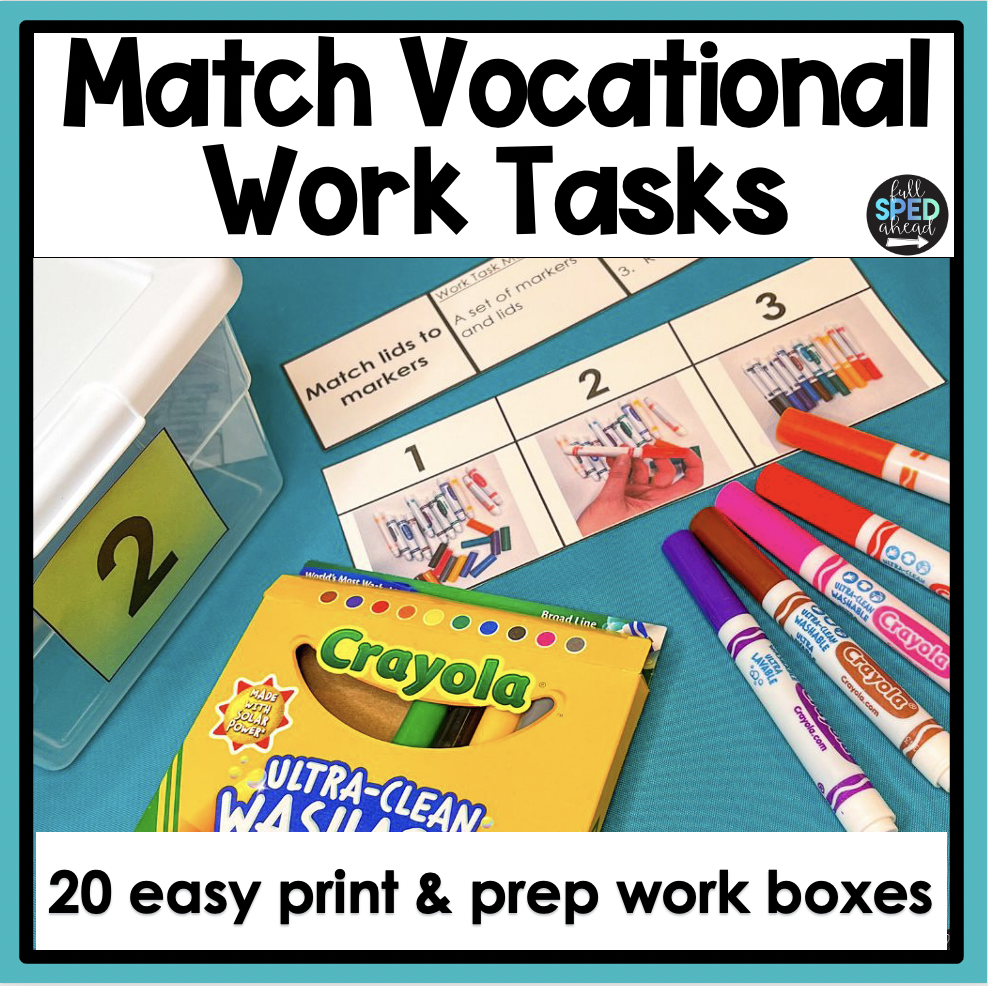Matching work tasks and activities can be an awesome addition to your special education classroom! This is a basic fine motor skill perfect for all ages and ability levels. Once my student has mastered put in work, they move to matching tasks!
Matching tasks are a valuable resource for promoting cognitive development and enhancing learning outcomes in special education classrooms. These tasks involve matching corresponding objects, pictures, or words, allowing students to strengthen their visual discrimination skills, improve attention to detail, and enhance their ability to identify and recognize patterns.
By incorporating matching tasks into the classroom routine, teachers can provide meaningful and engaging activities that cater to diverse learning needs. These tasks can be customized to target various skills such as shape recognition, color matching, letter identification, or even vocabulary expansion.
By offering opportunities for hands-on exploration and independent problem-solving, matching tasks foster a sense of achievement and build students’ confidence in their abilities. Additionally, they can be easily differentiated to accommodate individual learning goals, making them a versatile tool for educators working with students of varying abilities.
Introducing matching tasks in the special education classroom creates an inclusive learning environment that nurtures cognitive growth, promotes skill acquisition, and fosters a sense of accomplishment among students.
Want to know more about put in work tasks and learning? Read this post!

Matching is work activities where the student is putting something with another item that is the same or similar. There is no sorting, no assembling, no sequencing. It’s one basic fine motor movement. Pick up items and put them somewhere with their same item. This helps with activities matching game for kids too.
This basic fine motor activity is essential to teach our younger and foundational level learners how to work independently, how to increase work endurance, and attention. There is a clear start and ending point. You can increase the length and difficulty by using smaller items, using realistic images or items and increasing the number of items. You can work on generalization by making a lot of different versions of these tasks.
Looking for better ways to set up independent work, look no further!
Matching and pairing activities for preschoolers are great for students with low attention and fine motor abilities. I use these types of skills with basic learners to increase their work confidence and work endurance. We want matching tasks and activities to be simple so we can celebrate the wins for finding identical items. This is typically to promote longer work periods of time and endurance.
These are great tasks to introduce independent work. You can also use multiple choice tasks. Matching has a definite start and stop and can help students understand the foundational skills needed for independent work. Want to know more about independent work? Read this blog post!

You’re in luck! I have a set of matching work tasks in my TpT Store! Easy prep set of work boxes that you can print, prep and find materials in your classroom or local dollar store to set up and implement this school year!
Independent work tasks are important in every special education classroom! These task boxes can be used as teaching tools and building independence through student work.
This resource includes detailed instructions for teacher setup, Amazon list of possible materials, digital data tracking form, student visuals, teacher visuals and directions for use for 20 work tasks. These activities are for fine motor tasks that require a matching aspect.
Best part! You can either use the pre-created student visuals with images taken for you to show each step of the task OR you can create your own student visuals!
This resource requires the addition of some basic materials such as bins, office supplies, small containers. A detailed Amazon supply list is included to make it easy to determine what you will need to create all of these centers!
Looking for more ways to bring life skills into your classroom, read this post!
Furthermore, these tasks can be easily integrated into thematic units or specific topics of study, making them a versatile tool for reinforcing and expanding knowledge across different subject areas. For example, in a science lesson about animals, students can match pictures of animals to their corresponding habitats or sort animals based on their characteristics. In a language arts lesson, students can match rhyming words or associate words with their antonyms or synonyms. By incorporating matching into lesson plans, teachers can create engaging and interactive learning experiences that cater to diverse interests and learning styles.
To maximize the effectiveness of matching tasks, teachers can provide appropriate scaffolding and support based on individual student needs. They can start with simpler matching activities and gradually increase the complexity as students gain confidence and proficiency. Additionally, teachers can use visuals, prompts, and manipulatives to facilitate understanding and make the tasks more accessible.
In conclusion, matching tasks are a valuable tool in the special education classroom, offering a wide range of benefits across cognitive, social, and emotional domains. By incorporating matching tasks into lesson plans, teachers create opportunities for students to develop important skills while fostering a positive and inclusive learning environment. Whether used for individual practice, small group work, or as part of a larger instructional unit, matching provide engaging and meaningful learning experiences for students in special education settings.
Instagram | TeachersPayTeachers | Facebook | Boom Learning Library | Pinterest | Youtube
What are you looking for?
COPYRIGHT © 2025 Full SPED Ahead